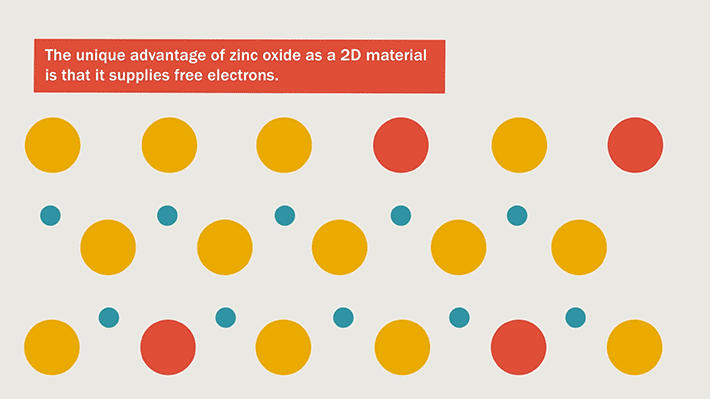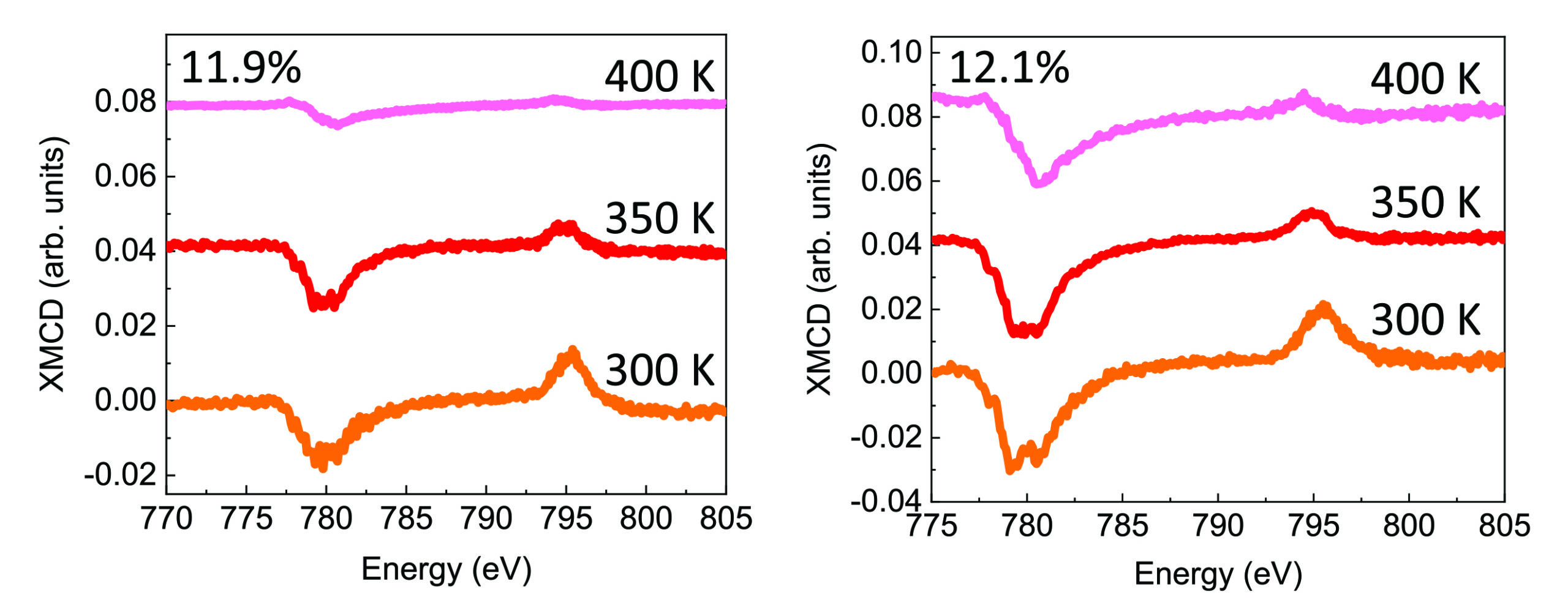SCIENTIFIC ACHIEVEMENT
Researchers have made the world’s thinnest (one atom thick) magnet that’s chemically stable under ambient conditions.
SIGNIFICANCE AND IMPACT
The two-dimensional material, magnetically characterized at the Advanced Light Source (ALS), could enable big advances in next-generation memory devices, computing, spintronics, and quantum physics.

A 2D magnet that can take the heat
The magnetic component of today’s memory devices is typically made of magnetic thin films. But at the atomic level, these materials are still three-dimensional—hundreds or thousands of atoms thick. For decades, researchers have searched for ways to make thinner and smaller magnets to store data at a much higher density. Previous achievements in the field of 2D magnetic materials have brought promising results. But these early magnets lose their magnetism and become chemically unstable at room temperature. Now, a team of researchers has synthesized a single atomic layer of zinc oxide, doped with cobalt, that exhibits spontaneous magnetization at room temperature and above.
A dilute cobalt-doped magnetic oxide

Graphitic zinc oxide (gZnO) is a layered material with a graphene-like honeycomb structure and strong stability in air. Magnetism can be introduced into the system through doping with Co atoms, producing the dilute magnetic oxide, Zn1‑xCoxO (gZCO). Synthesis of the gZCO is relatively simple, starting with a solution of graphene oxide, zinc, and cobalt. A few hours of baking in a conventional lab oven transforms the mixture into a single atomic layer of zinc oxide with a smattering of cobalt atoms, sandwiched between layers of graphene. A final annealing process, conducted at 400 °C in air for one hour, removes the graphene layers and highlights the strong chemical stability of gZCO crystals in ambient conditions.
Pinpointing the magnetization source
A wide variety of experimental techniques confirmed the 2D morphology of the gZCO, revealed the valence state of the Co impurities (Co2+), provided clear evidence of spontaneous magnetization at ambient conditions, and ruled out metallic cobalt or cobalt oxide clusters as possible sources of the magnetism.
At ALS Beamline 6.3.1, the researchers performed x-ray magnetic circular dichroism (XMCD) experiments at the Co L2,3 edges at high temperatures. XMCD measures the difference between two x-ray absorption spectra, taken with the incident x-rays directed parallel and antiparallel to the magnetization. Thus, nonzero XMCD features indicate the presence of ferromagnetic long-range order. The location of the features (i.e., prominent dips centered at 780.5 eV) are consistent with the L3 edge of Co2+ states. Therefore, the origin of the ferromagnetism in gZCO is explicitly attributed to the strongly coupled Co2+ ions in the gZnO matrix instead of Co clusters, in agreement with the other analyses.

Free electrons keep magnetic atoms on track
The experimental results are consistent with a model in which charge carriers (free electrons or holes) act as intermediaries in ensuring the alignment of the Co magnetizations. In this framework, the Co concentration plays an important role, thus affirming the intriguing possibility of tuning the magnetism by changing the doping level.
In general, the development of an ultrathin magnet, fabricated using a scalable process and that operates at room temperature, could not only lead to new applications in computing and electronics—such as high-density, compact spintronic memory devices—it also marks a crucial step forward in the realization of new tools for the study of quantum and topological phases at ambient conditions.
Contact: Jie Yao
Researchers: R. Chen, Y. Song, S. Wu, J. Cao, F. Yang, Y. Liu, S. Lou, X. Chen, Q. Wang, R.J. Birgeneau, and J. Yao (UC Berkeley and Berkeley Lab); F. Luo and Z. Fang (UC Berkeley and University of Electronic Science and Technology of China); Y. Liu and D. Jin (Argonne National Laboratory); Y. Dong, J. Huang, and H. Yuan (Nanjing University, China); A. N’Diaye and P. Shafer (ALS); and R. Cheng (UC Riverside).
Funding: Intel Corporation; Bakar Fellows Program, UC Berkeley; U.S. Department of Energy, Office of Science, Basic Energy Sciences program (DOE BES); and National Natural Science Foundation of China. Operation of the ALS is supported by DOE BES.
Publication: R. Chen, F. Luo, Y. Liu, Y. Song, Y. Dong, S. Wu, J. Cao, F. Yang, A. N’Diaye, P. Shafer, Y. Liu, S. Lou, J. Huang, X. Chen, Z. Fang, Q. Wang, D. Jin, R. Cheng, H. Yuan, R.J. Birgeneau, and J. Yao, “Tunable room-temperature ferromagnetism in Co-doped two-dimensional van der Waals ZnO crystals,” Nat. Commun. 12, 3952 (2021), doi:10.1038/s41467-021-24247-w.
Adapted from the Berkeley Lab news release, “Main Attraction: Scientists Create World’s Thinnest Magnet.”
ALS SCIENCE HIGHLIGHT #452